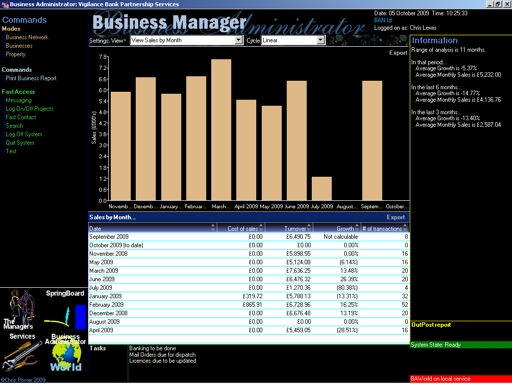Business overview

Business Manager exists to provide information on sales from a number of perspectives as well as a variety of tools for doing business and managing businesses. The perspectives include sales by day, month, sales by industry, salesperson, project and product. The financial systems are also initiated from Business Manager.
Business Manager provides live up-to-the-second information with some commentary, and its results should provide clues for strategic management and business development. It should help you identify top buying customers, top selling salespeople, most profit-yielding stock, helping to identify the highest performing projects as well as offering notions on trends from a variety of perspectives.
To see statistics on sales, choose the point of view, and all will be revealed. Also, information on the top statistics is pointed out on the Information Bar.
Business Manager ultimately offers the chance to see where your strongest sales lie and patterns to them, thus suggesting ideas on where to take the business next. It is fair to say that businesses are always on the move, and Business Administrator will try and show you how your business is moving and help you keep up. The information often reveals surprises, and, without it, the opportunity to make informed decisions arises, without which frequently lead a company down the wrong road and on to failure. Without this information, one could fail to take advantage of unforeseen opportunities. This is one of the ways that Business Administrator turns business weaknesses back into strengths, and provides for elite strategic decision-making.
Modes
Businesses: offers graphical views of the positions of your businesses relative to each other. Policies for each business are set here.
Business Performance: provides details on sales over a variety of perspectives and date ranges. Polcies regarding general business settings are also here.
Property: provides details on the properties you use. If it’s kept up to date, information about them will be included in financial and tax analyses. It includes tools to support property acquisition.
OutPost Business: offers a variety of facilities for measuring the performance of OutPosts. OutPosts are web databases, and are not for the faint-hearted. It is Business Administrator’s way of building relationships with such databases.
Commands Overview
Policies: A variety of policies are available here that are targeted to each specific business. Sub-business use the template of the legal entity, the mother company. Quote defaults refer to the production of sales quotations, and you can set the default headers and footers for printing quotations. The defaults can be changed at the moment of print.
New Business: This function allows you to create a new daughter business. You cannot create a new legal entity with this command: the legal entity is defined when the database was first built.
Edit Business Details: Conversely, you can edit the details of the selected business.
View Sales [by perspective]: This provides live up-to-the-second information, with some commentary, and the results should provide clues for strategic management and business development. It should help any business identify top buying customers, top selling salespeople, most profit-yielding stock, etc, as well as helping to identify the highest performing projects. Most particularly, it should identify the patterns and principles of your successful trade so that you can focus all initiatives on it.
Invoices by Month: When assessing business trends, particularly Sales by Month, it may be necessary to view the invoices issued in a particular month. This function allows you to do so.
Print Business Report: with this command, you can run a printout of sales data for distribution for collaboration purposes or otherwise.
Output Sales Data to Excel: You may want to run various analyses on data beyond Business Administrator’s capabilities, e.g., trends, etc. By clicking on this command Business Administrator will export all available, relevant data to a new Excel file.
Business Settings: This system defines the parameters that you run the business on. Before it can be used (and if you haven't already done so) you need to enable the Financial Systems.
Generally, you run execute the invoice run whenever you like: Business Administrator has no particular preference on when it should be executed. But, to some companies this matters, and you can ask Business Administrator to execute the invoice run automatically.
Obsoletion of data occurs throughout Business Administrator. Here, you can say when obsoletion starts to occur, and items become hidden. Choose as you see fit – you can change it again later. Data does not get deleted.
Edit Property Details: Edit details of the property that’s selected. It is essential to keep details on properties up to date.
Property Acquisition: You ought to use this tool when you acquire a property. It’s your way fo telling Business Administrator about each of the properties you have. That way, Business Administrator can account for them properly and deal with cost and tax issues.
View OutPost Timeline: Assuming you register information from your website, Business Administrator will provide you with a timeline that shows all the events that happened on your website. Essentially, it shows the pages people visited, when, and the path through it.
Site Usage Cycle: shows how pages on the website have been visited: particularly a count of the times they’ve been visited.
Product Analysis: This shows an analysis of how products on your website have been viewed.